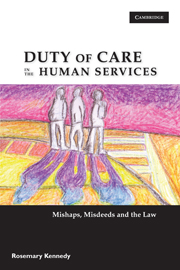Book contents
- Frontmatter
- Dedication
- Contents
- Acknowledgements
- Author's note
- Part 1 Positioning and mapping the territory of human service mishaps and misdeeds
- Part 2 Mishaps and misdeeds through a law lens
- Chapter 3 Public law of general application
- Chapter 4 Public law of particular relevance to the human services
- Chapter 5 Private law and suits
- Chapter 6 Private law – negligence
- Chapter 7 Private law – other torts and civil actions
- Chapter 8 Legal processes, quasi and indirect legal scrutiny
- Part 3 Mishaps and misdeeds through a human services lens
- Part 4 Mishaps and misdeeds through a unified lens
- Appendix: Finding the law and cases
- References
- Index
Chapter 6 - Private law – negligence
from Part 2 - Mishaps and misdeeds through a law lens
Published online by Cambridge University Press: 05 June 2012
- Frontmatter
- Dedication
- Contents
- Acknowledgements
- Author's note
- Part 1 Positioning and mapping the territory of human service mishaps and misdeeds
- Part 2 Mishaps and misdeeds through a law lens
- Chapter 3 Public law of general application
- Chapter 4 Public law of particular relevance to the human services
- Chapter 5 Private law and suits
- Chapter 6 Private law – negligence
- Chapter 7 Private law – other torts and civil actions
- Chapter 8 Legal processes, quasi and indirect legal scrutiny
- Part 3 Mishaps and misdeeds through a human services lens
- Part 4 Mishaps and misdeeds through a unified lens
- Appendix: Finding the law and cases
- References
- Index
Summary
THE MOST COMMON tort law action in the human services has been negligence. Negligence involves unintentional but blameworthy wrongs done to others, for which the wrongdoer can be held responsible in law. At the core of negligence is a failure to meet the standards of the time.
For a negligence action to succeed, three critical elements must be established by the plaintiff and for each element much will hang on the nature of the relationship between the plaintiff and the alleged wrongdoer. The elements are:
the plaintiff was owed a duty of care by the alleged wrongdoer
the wrongdoer breached the duty of care
the breach caused the reasonably foreseeable harm to the plaintiff.
This chapter considers these three elements of negligence in relation to child protection, stolen generations, correctional and immigration detention cases.
DUTY OF CARE
The phrase ‘duty of care’ is in the title of this book due to widespread use in the human services. However, as argued elsewhere (Kennedy and Richards 2007), the meaning of duty of care in the human services is inchoate and probably bears little resemblance to the very particular way in which it is used in the law. Duty of care in law concerns the relationships between parties and is a question of law at any one time – it is not a question of fact, of the views of the parties involved, or of morality or ethics.
- Type
- Chapter
- Information
- Duty of Care in the Human ServicesMishaps, Misdeeds and the Law, pp. 104 - 124Publisher: Cambridge University PressPrint publication year: 2009



